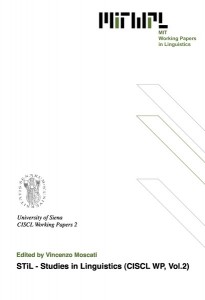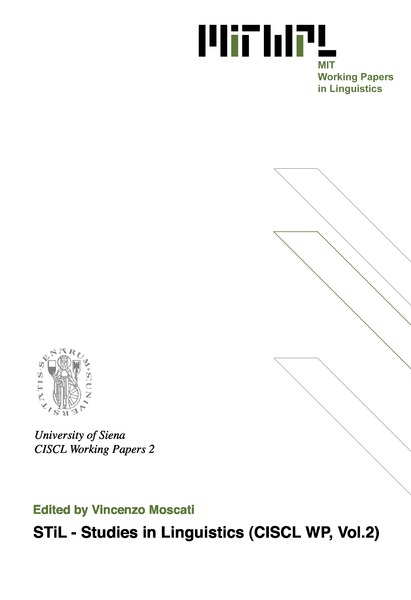University of Siena CISCL Working Papers #2
STiL - Studies in Linguistics (CISCL WP, Vol.2)
Vincenzo Moscati, 2008
The CP of clefts
ADRIANA BELLETTI, Ciscl - University of Siena
[no abstract available]
Preposed Object and Low Periphery in Mandarin Chinese
LINDA BADAN, City University of Hong Kong
In this paper I analyse the Low Periphery in Chinese, following the basic lines of Belletti (2001, 2004) and Paul (2005). Like Italian, I show that Chinese displays Topic and Focus projections within IP. I individuate two different Functional Projections occupied by two distinct elements: the bare preposed Object (between Subject and verb) and the sentence-internal lian even+XP. Moreover I show that both have moved with A-movement. Contrary to the traditional analysis (Ernst & Wang 1995; Shyu 1995, 2001 among others), I finally argue that the bare preposed Object is not a Focus, but a Topic-like element with a Focus stress and it can be analyzed as a Contrastive Topic.
The Cartography of Syntactic Structures
GUGLIELMO CINQUE, University of Venice; LUIGI RIZZI University of Siena
[no abstract available]
Minimizers and quantifiers: a window on the development of negative markers
JACOPO GARZONIO, Universit di Padova; CECILIA POLETTO, Universit di Venezia
In this work we examine the diachronic development of two types of negative markers showing that their semantic evolution is similar, as they have both undergone a stage when they become monotone decreasing quantifiers. However, their position is different: the first type, called minimizers, are part of a complex DP, while the second is a bare quantifier. Their original syntactic position determines the final position where they are merged when they are reanalyzed as standard negative markers: the bare quantifier is located in a position dedicated to bare QPs, while minimizers move to a higher position in the low IP area.
Phases, Strong Islands, and Computational Nesting*
VALENTINA BIANCHI, University of Siena; CRISTIANO CHESI, University of Siena
This paper is an attempt to recast the connectedness condition (Kayne 1983) in derivational terms: we will show that a Top-Down derivation is adequate to describe strong island conditions (as in Huangs original proposal), without loosing the ability to discriminate among distinct phenomena (preverbal subject islandhood, complex-NP constraint, special properties of the first argument in double object constructions, intermediate status w.r.t. extraction/ gapping, for right adjuncts), and predicting, moreover, the grammatical distribution of parasitic/licensed gaps in the derived structure.
Number and Case in the comprehension of relative clauses: Evidence from Italian and Greek
MARIA TERESA GUASTI, University of Milano-Bicocca; STAVROULA STAVRAKAKI, University of Thessaloniki; FABRIZIO AROSIO, University of Milano-Bicocca
[no abstract available]
On the residual omission of Determiners in Italian L1: a case study
IDA FERRARI, University of Florence/Ciscl-University of Siena; SIMONA MATTEINI, Ciscl-University of Siena
This study deals with the acquisition of functional categories. Specifically, it focuses on determiner omissions in L1, a widespread phenomenon of early grammar which is subject to variation among languages (Chierchia et al., 1999; Guasti et al., 2004). We analyze here the spontaneous production of one Italian monolingual child. On the basis of the distribution of D in this language, we took into consideration semantic/syntactic properties of nominals that are crucial for the licensing of determiners in Italian. Results indicate that, during the period analyzed, D omission is a residual phenomenon more related to the structural configuration in which nominals occur rather than to other properties of Ns. In particular, an interesting selectivity emerges as for the non-target patterns are concerned: items involved in the high DP structures seem to play a crucial role in defining the conditions under which determiners are dropped in L1 grammar.
V1, V2 and criterial movement in Icelandic
IRENE FRANCO, University of Siena - CISCL
In this paper I argue that V1 and V2 orders are the outcome of criterial movement to the CP layer of, respectively, a null OP and an XP. Under the assumption that discourse-related properties are encoded in the CP, I propose a cartographic analysis of the mechanisms determining V1 and V2 orders in Icelandic. I show that the labels V2 and V1 are too generic and misleading because they cover constructions with different interpretive properties. On the one hand there are V2 orders found in declarative clauses, which can be distinguished into topic- or subject-initial. On the other hand, V1 orders are marked constructions, where the verb moves to a high position in CP and is preceded by a null OP with a scope-discourse related function. As a consequence, pure verb-initial constructions are not found in Icelandic, and, more generally, in Scandinavian. Nonetheless, it is syntactically visible that topic-initial declarative V2 and subject-initial V2 have different pragmatics with respect to what is commonly labelled as V1.
A Bilingual Treebank (ITA-LIS) suitable for Machine Translation: what Cartography and Minimalism teach us
CRISTIANO CHESI*, GIANLUCA LEBANI+, MARGHERITA PALLOTTINO*
*CISCL - University of Siena, +CIMeC - University of Trento
In this paper we describe some technical and theoretical aspects related to a manually aligned bilingual treebank Italian (ITA) Italian Sign Language (LIS) provided with both constituency and dependency annotation (Siena University Treebank, SUT). We briefly discuss the linguistic rationale behind the feature set and the dependency/constituency structure we adopted. Moreover we discuss the tool we used to annotate, semi-automatically, the treebank that, in the end, will be evaluated qualitatively with respect to a specific Transfer-Based Machine Translation (TB-MT) task.

